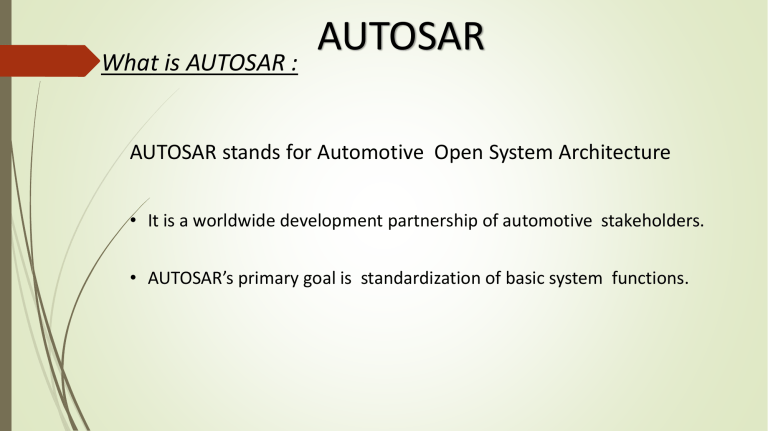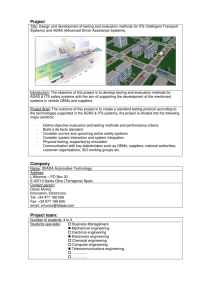
What is AUTOSAR : AUTOSAR AUTOSAR stands for Automotive Open System Architecture • It is a worldwide development partnership of automotive stakeholders. • AUTOSAR’s primary goal is standardization of basic system functions. AUTOSAR AUTOSAR Architecture : AUTOSAR is an open system architecture for automotive software development and provides standards for developing common automotive software applications. It is a growing and evolving standard that defines a layered architecture for the software. The classic AUTOSAR platform runs on a microcontroller and is divided into 3 main layers; let us discuss them in detail: • Basic Software Architecture- It is common to any AUTOSAR ECU. • AUTOSAR Runtime Environment • Application Layer CAN What Is a CAN Bus and What Role Does It Play in Automotive Systems? A controller area network (CAN) bus is a high-integrity serial bus system for networking intelligent devices. CAN busses and devices are common components in automotive and industrial systems. Using a CAN interface device, you can write LabVIEW applications to communicate with a CAN network. CAN How CAN Communication Works As stated earlier, CAN is a peer-to-peer network. This means that there is no master that controls when individual nodes have access to read and write data on the CAN bus. When a CAN node is ready to transmit data, it checks to see if the bus is busy and then simply writes a CAN frame onto the network. The CAN frames that are transmitted do not contain addresses of either the transmitting node or any of the intended receiving node(s). Instead, an arbitration ID that is unique throughout the network labels the frame. All nodes on the CAN network receive the CAN frame, and, depending on the arbitration ID of that transmitted frame, each CAN node on the network decides whether to accept the frame. If multiple nodes try to transmit a message onto the CAN bus at the same time, the node with the highest priority (lowest arbitration ID) automatically gets bus access. Lower-priority nodes must wait until the bus becomes available before trying to transmit again. In this way, you can implement CAN networks to ensure deterministic communication among CAN nodes. CAN Low Speed CAN High Speed CAN CAN FD CANopen Used for faulttolerant systems that do not require high update rates. The maximum data transfer rate is 125 kbps, but the wiring is thus more economical than high-speed CAN. In automotive applications, lowspeed CAN is used for diagnostics, dashboard controls and displays, power windows, etc. Used for communications between critical subsystems that require high update rates and high data accuracy (e.g., antilock braking system, electronic stability control, airbags, engine control units, etc). Data transfer speeds of high-speed CAN ranges from 1 kbit to 1 Mbit per second. The latest version of CAN introduces a flexible data rate, more data per message, and much higher speed transmissions. The data length within each standard CAN message is 8 bytes, but with CAN FD this has been increased 800% to 64 bytes of data CANopen is a higherlayer protocol that is used for embedded control applications. Because it is based on the CAN messaging protocol, DAQ systems and data loggers that can read and record CAN data can also access data from CANopen. ADAS What is ADAS: ADAS stands for Advanced Driver Assistance Systems It is an advanced driver assistance systems. This is an electronic system that helps the driver of a vehicle to driver more safely and conveniently Advanced Driver Assistance System (ADAS) helps vehicle drivers to drive safer and more convenient ADAS The principle of operation of ADAS: ADAS driver assistance device works based on information obtained from multi-function camera combined with sensors. They are installed on the outside of the vehicle, mainly on the top, front, rear and sides of the vehicle body to record images of various objects and traffic sign languages such as streets, vehicles, road signs. pedestrians, pedestrians and other objects. Thanks to the information provided, ADAS has the ability to detect potential dangers, thereby giving warnings as well as proactively intervening in cases where the driver is distracted. The principle of operation of ADAS ADAS Classification of safe driving assistance features: Adaptation Automatic Monitoring Warning • Adaptive Steering Assist helps the car make small adjustments for safer driving based on data from its surroundings. Typically, the adaptive cruise control system (ACC Adaptive Cruise Control) uses radar or laser sensors to detect the distance between vehicles and automatically adjusts the speed to maintain the optimal distance, ensuring that safe. • The automatic safety assistance system can control the vehicle itself in the event of an impending collision. One of the great safety features of this ADAS is the automatic emergency braking system (AEB). AEB helps warn the driver when an accident is imminent and automatically applies emergency braking to avoid a collision. • The safety assist monitoring system uses cameras and sensors to increase visibility into safetycritical data, such as emergency braking or rolling over stops. The Traffic Sign Recognition (TSR) feature provides information to help drivers easily identify the signs. • This is an automatic warning system in the cabin, helping the driver to anticipate possible risks when participating in traffic. For example, the front collision warning (FCW) function measures the distance, angle and relative speed between the vehicle and other objects on the road, to alert the driver of impending collisions by sound. RADAR What is RADAR: RADAR stands for RAdio Detecting And Ranging It is based on the use of radio waves. Radars send out electromagnetic waves similar to wireless computer networks and mobile phones. The signals are sent out as short pulses which may be reflected by objects in their path, in part reflecting back to the radar. When these pulses intercept precipitation, part of the energy is scattered back to the radar. RADAR Components Of The Radar: Radars in their basic form have four main components: • A transmitter, which creates the energy pulse. • A transmit/receive switch that tells the antenna when to transmit and when to receive the pulses. • An antenna to send these pulses out into the atmosphere and receive the reflected pulse back. • A receiver, which detects, amplifies and transforms the received signals into video format. Radar output generally comes in two forms: reflectivity and velocity. Reflectivity is a measure of how much precipitation exists in a particular area. Velocity is a measure of the speed and direction of the precipitation toward or away from the radar. Most radars can measure reflectivity but you need a Doppler radar to measure velocity.


